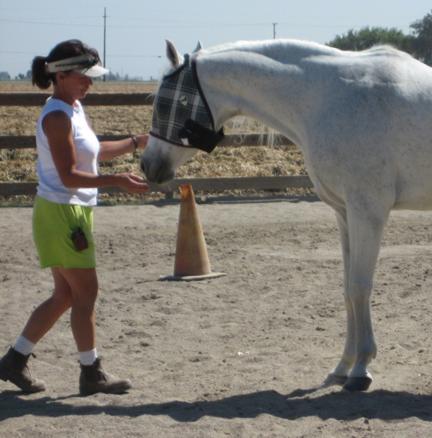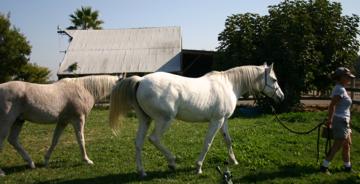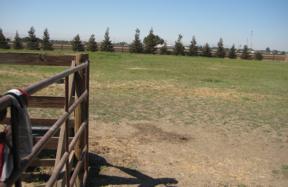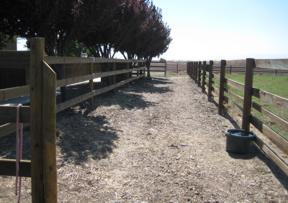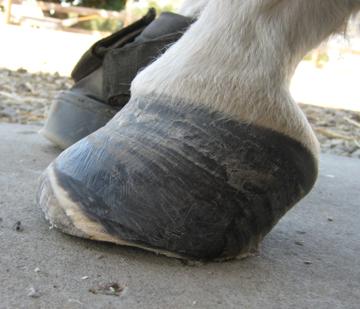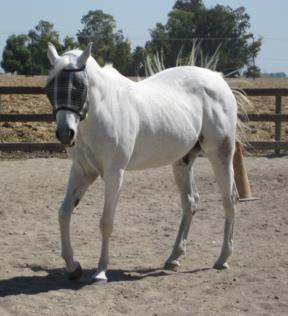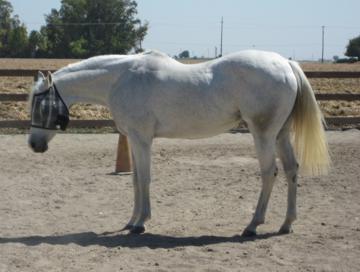 |
HealthyHoof.comHoofcare & Information for Barefoot SoundnessLinda Cowles Hoof Care - Serving the greater SF Bay Area and Northern California |
Fancy's Memorial, October 2008See Fancy & Founder 10/2005From 10/2005 " These pictures are of a young arabian mare named Fancy and her devoted owner. Fancy has the unfortunate honor of being my first in-progress founder diagnosis... I've dealt with many horses that foundered in the past, but Fancy was the founder that I recognized before her vets did... she was my first. Honestly? I wish there hadn't been a first." Below, Fancy in October 2005 when I first saw here, To the right, Fancy when I last saw her in mid September, 2009 |
|
|
|
January 2009 Postscript...Sabra spent 2005 through 2008 working with the various laminitis experts I suggested she contact as well as finding new experts to assist her with Fancy's condition. I was over two hours away, too far away to be able to help her on a regular basis, and Sabra is resourceful and quickly became her own most valuable resource, an expert in diet, laminitis and founder management. She consulted with Dr Eleanor Kellon on diet, and worked with several founder experts to help her with trimming. Keith Seeley devoted many hours to reviewing x-rays and photos and guiding Sabra's farrier's and trimmers over the phone. Still, Fancy's condition continued to decline.... Continuing Laminitis Episodes?The primary problem, aside from Fancy's IR status, was that the pastures on Sabra's ranch were still available on occasion. Sabra's husband is a dedicated rancher who found it difficult to grow a less than luxurious pasture, much less turn under a 5 pasture to turn it into a large dry lot. Sabra loved letting her horses graze... like so many of us, seeing your horses out on a green pasture spoke to her soul. And the fact is that Fancy, like all horses, loved pasture with a passion that was hard to deny, and was insistent and pleading when the other horses got to graze and she couldn't, which was emotionally hard on Sabra. So Sabra continued to let Fancy graze, usually in 30 x 70 foot paddock with very sparse grass, and tried very hard to be careful about when she grazed and how much grass she consumed. Sabra knew it was playing russian roulette, but felt that grazing meant too much to Fancy to deny it to her completely. She sometimes wore a muzzle, usually when she was on the big pasture. Fancy was often okay with this routine, but in spite of Sabra's caution, "a little pasture" was often far too much, and Fancy would have another painful laminitis attack. As the years went by, the laminitis attacks added up, the vascular damage caused by laminitis accumulated, and the circulation in Fancy's lower legs deteriorated to the point where her feet and legs had to stay wrapped in thick padding when it got cold. Her blood supply was inadequate to keep them warm, and the lack of heat in her legs and feet could trigger an attack.
|
|
This was the turnout pasture (10/2008) shared by Sabra's horses and occasionally Fancy. It wasn't "lush" but the stressed grasses were enough to trigger ongoing laminitis episodes. |
By September 2008, Sabra had built a large turnout adjacent to the turnout pasture so that Fancy could be close to the other horses in the pasture. This paddock still had a little grass in it, barely visible in this shot, but it was not much. Fancy was despondent when not allowed to graze with the other horses. |
September 2008In early September, Sabra called and asked if I could come do a trim consultation. We had kept in touch over the phone several times a year, I hadn't seen Fancy personally in more than 2 years. I had client visits 45 minutes from her on September 17th and added her to the schedule. The trimmer who had been working with her agreed to meet us. Fancy's feet had changed over time into a conformation typical of horses with chronic laminitis, and as the shape changed, Fancy became more and more uncomfortable. Sabra trusted her trimmer, but wanted a second opinion to ensure that everything possible was being done to help Fancy live comfortably. I had worked with several other very extreme founders in the meantime, and hoped that Fancy's discumfort was simply a trimming problem. It wasn't. When I arrived at Sabra's that afternoon, she let me know that Fancy was having another laminitis attack, and added that another horse, a young Arabian gelding, had had mild attacks too. I trimmed all three horses, but was careful with Fancy because she had mild pulses and all I wanted to do was to attempt to make her more comfortable. Her regular trimmer had done a good job, and had trimmed her 4 or 5 weeks before. A lot of retained sole had accumulated, and her toe was longer than it needed to be, so there was work for me to do. As I let her know that I didn't feel she would see an improvement, Sabra looked at me with tears in her eyes and said that Fancy was tender more often than not. She felt horrible because Fancy was still sore. She couldn't run, she couldn't graze, she couldn't be ridden... No Miracles...We discussed euthanasia. I had to let Sabra that at this stage of chronic laminitis, there were no miracle cures, and that if letting Fancy go felt right, then it was time. We turned Fancy out in the soft arena, where she spent most of her time recently, and watched her move. She was moving easier than prior to my trim, but no more comfortably. Trimming Chronically Laminitis HorsesThe problem with chronic laminitis is that the pain usually isn't a direct result of the shape of the hoof capsule. The natural shape of the laminitis hoof capsule is a result of the internal damage compounded over time, and while a chronically laminitic horses pain can sometimes be lessened by modifying the trim, a great trim can't fix the condition itself. A trim can't undo the damage caused by a severe metabolic or dietary imbalance, and any trim on a chronic foot can trigger more inflammation. What works best?If you have even mild laminitis, keep your horses off **all** pasture grass - even short sparse grass - from late fall until early summer. Short grass is more stressed and often has significantly higher NSC (non-structured carbohydrates) than longer, lush looking grass. Purchase tested grass hay or soak grass hay daily to remove sugars. Avoid pelleted feed unless its tested as low carb, and stop feeding any grain or grain hays like Barley and Oat, which are higher carb. Do your research to educate yourself on the symptoms and causes of laminitis. Your vet can guide you, but most vets are not laminitis experts and new research and discoveries are announced and tested each year. Use the Internet to learn as much as you can.
|
Fancy's front left shows the accumulated damage of ongoing laminitis. |
Fancy, still a young horse, had difficulty turning and moving comfortably without her boots. Soft Ride Boots helped, but only reduced her discomfort. |
|
|
|
Sabra's Sad Tracy Clinic Announcement, October 2008I was scheduled to hold a clinic in Sabra's neighborhood in early October, 2008, and I agreed to swing by and do what I could for Fancy the night before. Sabra would be attending the clinic the following day as she wanted to start trimming her own horses. When she called me during the week preceding the clinic, she left a tearful phone message letting me know that she'd let Fancy go, had her put to sleep, I felt a great sadness... I felt bad for Fancy, a phenomenally athletic and passionate mare who had met an unfortunate end, but I felt just as bad for Sabra. Sabra loved her horses very much, they were her children, her life. This was very hard for her. Sabra had felt so much conflict over everything that happened following Fancy's initial diagnosis in 2005. When she did everything that would keep Fancy healthiest, Fancy was agitated and angry that other horses got to go out on pasture and she didn't. She knew Sabra well, and pleaded convincingly, begging to be put out with the other horses. She pouted and sulked, turned away from Sabra and rejected her affection one minute, then looked hopefully towards the pasture, and back to Sabra, repeatedly. Pasture was her joy, and she didn't understand why it was denied to her. When Sabra relaxed her rules and let Fancy graze, it eventually caught up with her and they both suffered. Horribly. Sabra has two other horses, and one of them is beginning to have mild laminitis episodes. Sabra did all of the Tracy Clinic attendees a huge favor by attending the clinic, and with tears streaming down her cheeks, described her battles with laminitis, diet and the toll that pasture turnout, even carefully managed turnout, had on her beloved mare. |
|
A Trimmers Dilemma....I run into this owner resistance to denying their horse pasture constantly... and I see the reluctance to face potential pasture-triggered laminitis in myself, too. Sometimes these horses are on turnout in large paddocks with barely enough grass to show a green fringe, but that fringe is cropped close and stressed, and may be the straw that breaks the camels back when a horse is borderline IR and seasonal ACTH levels rise in the spring and fall. As I was writing this article, I received a voice mail from a client who owns a draft horse, a splendid percheron. We took this big guy barefoot in May of 2007. He had side bone and signs of ring bone, and significant flare and deep digital decent, but transitioned easily. His feet did fine all summer, getting stronger each trim as he grew in a well connected wall and dense sole. As winter grew close, right after New Years, he started getting tender and we began to have wall separation. I mentioned the pasture several times, repeated my litany that grass gets toxically rich in the winter and... each trim I would point out the continuing wall separation. Then in early April, I arrived to find his feet flat soled and his walls cracked and flared with wall separation completely around the perimeter of all four feet. A month later, he started abscessing. Mild Laminitis. The vet wouldn't say it, the vet suspected that the soles had gotten sensitive because of moisture, but the horse had been in a wet pasture for several months. The mild laminitis symptoms were all there. So here it is again, early winter. This horse has been sound, and now? Its starts again. The phone call. The owners think its the trim, but my trim this month was the same as it was the month before, or more conservative if anything. Take these horses COMPLETELY off of grass. Please. Remember Fancy.
|
|
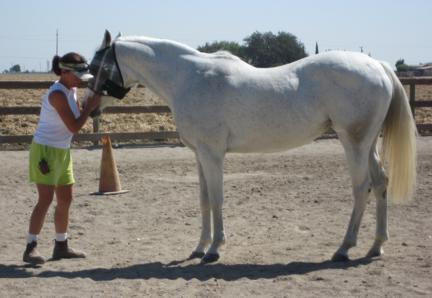 |
|
|
|
Serving the greater SF Bay Area & Northern California
Home | Contact Linda | Privacy | About Us
